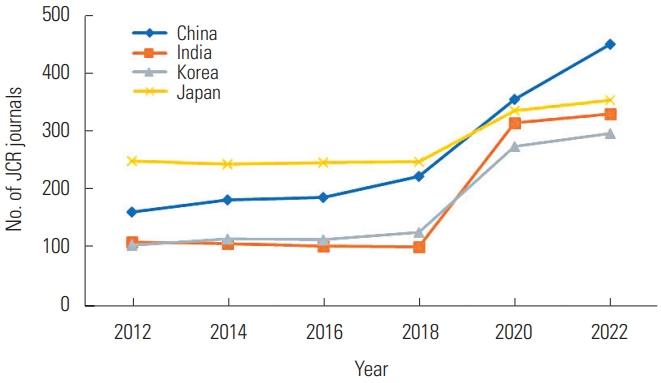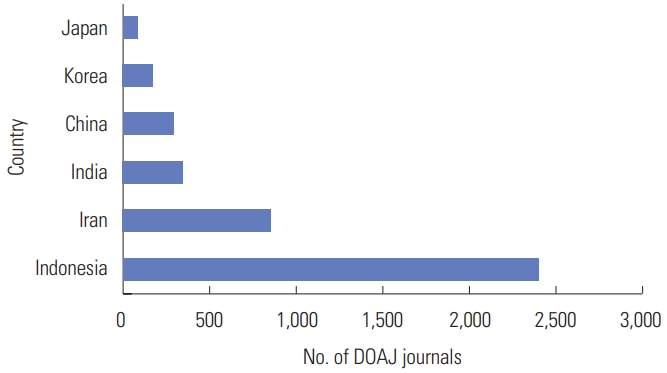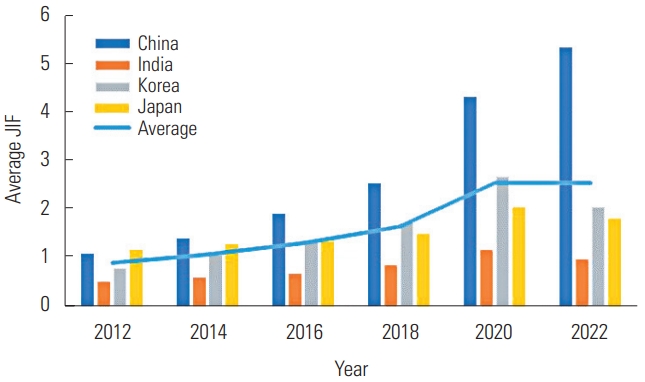Reflecting on the past 10 years of Asian scholarly journals
Article information
Science Editing is the official journal of the Korean Council of Science Editors (KCSE) and the Council of Asian Science Editors (CASE). It aims to improve the culture and health of human beings by promoting the quality of editing and publishing in Asian scholarly journals [1]. This July marks the 10th anniversary of the establishment of CASE. Herein, I would like to investigate the changes that have occurred in Asian scholarly journals over the past decade.
To this end, it is of particular interest to examine the development of Asian scholarly journals in an international indexing database, such as Journal Citation Reports (JCR) of Clarivate. Over the past decade, the number of JCR-listed journals from Asian countries has been on the rise. Notably, China, Korea, and India have shown remarkable growth. By 2022, the number of JCR-listed journals from each of these three countries matched or exceeded that of Japan, which stood at around 350. Since 2019, China has surpassed Japan in this regard (Fig. 1). Additionally, the average journal impact factor (JIF) of Chinese journals is the highest among those from Asian countries (Fig. 2). As reported by the SCImago Journal & Country Rank (SJR; https://www.scimagojr.com), China has been the world’s leading producer of scholarly papers since 2020. Other countries are making significant strides as well. Vietnam and Indonesia have been included in the JCR in 2019 and 2020, respectively. Notably, Indonesia has emerged as the country with the largest number of journals in the Directory of Open Access Journals (DOAJ; https://doaj.org) (Fig. 3).

Number of Journal Citation Reports (JCR) journals of the top four Asian countries (2012 to 2022 biennially).

Number of Directory of Open Access Journals (DOAJ) journals of the top six Asian countries (as of February 1, 2023).
Scholarly journals in Asian countries have experienced significant growth over the past decade. This surge can be attributed to the rapid development of science and technology across most Asian nations during this period. Additionally, some countries have been actively implementing policies to promote the development of national scholarly journals. In Korea, a variety of initiatives have been undertaken to internationalize domestic journals over the past ten years. Organizations such as the KCSE and the Korean Association of Medical Journal Editors (KAMJE) have played pivotal roles in educating journal editors and assisting journals in adopting advanced publishing guidelines and standards. Since its establishment in 2012, KCSE has conducted regular seminars, training approximately 5,000 editors. During this time, around 50 KCSE-affiliated journals have been newly indexed in international databases. Vietnam and Indonesia, alongside Korea, have been among the most active participants in CASE.
However, the quality of Asian scholarly journals still has room for improvement. The typical standard for evaluating the quality of scholarly journals is the number of citations they receive in international journal indices. Looking forward to the next decade, editors of Asian scholarly journals should focus on increasing the impact factors of their publications. Collaboration through CASE is highly encouraged. As the Secretary-General of CASE, I am eager to see many Asian journal editors participate in the Eighth Asian Science Editors’ Conference and Workshop, which will take place in Jakarta, Indonesia, on July 15 and 16, 2024. This event will provide an excellent platform to initiate such discussions [2].
Notes
Conflict of Interest
Tae-Sul Seo is the Secretary-General of the Council of Asian Science Editors (CASE), serving from August 2022 to July 2024. Tae-Sul Seo also serves as an Editor of Science Editing since 2023, but had no role in the decision to publish this article. No other potential conflict of interest relevant to this article was reported.
Funding
The author received no financial support for this work.
Data Availability
Data sharing is not applicable to this article as no new data were created or analyzed.
Supplementary Materials
The author did not provide any supplementary materials for this article.

